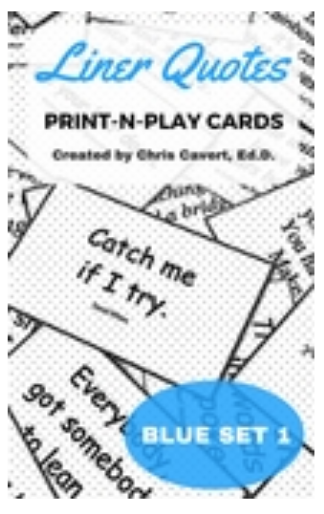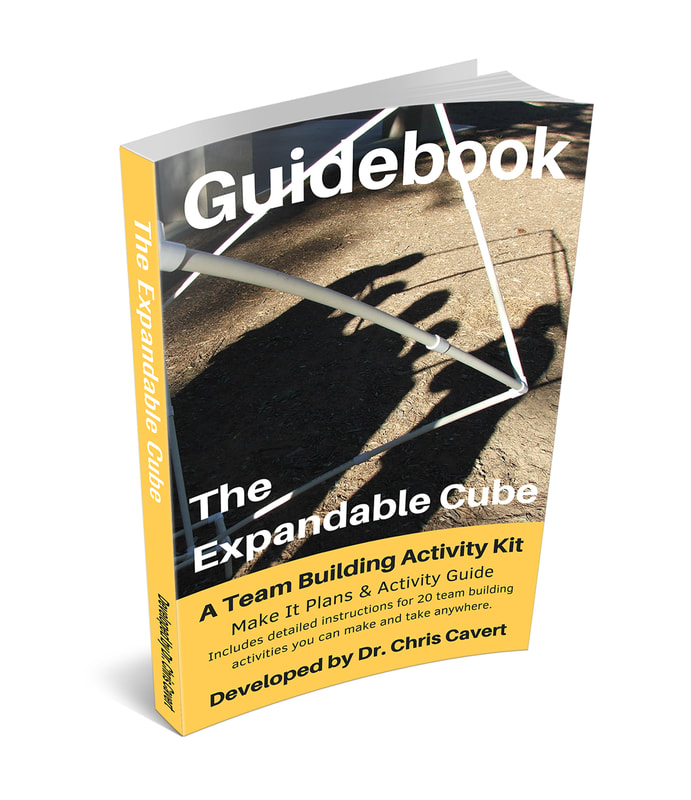One of my go-to activities with large letter tiles is Word Builder. Sam Sikes and I shared this one in, "50 More Ways to Use Your Noodle" back in 2002. Before Sam and I had access to Jumbo Bananagrams (currently unavailable - bummer!) and Crowd Words (shown in the picture above) we sliced up noodles into 1.5 inch thick 'chips' and wrote letters on them (see Scrabble to make your set) to play letter-prop team builders. (Those were the days....) Anyway, back to the present...
'Building' in the Dark: Team building 'in the dark' poses some interesting challenges - most notably, the light (or lack of). The first prop chosen was a small camping lantern (low light, USB rechargeable) for each group/table and one for the letter cards table. Word Builder involves placing all of the letter cards (or tiles, about 120) on the ground where participants go out to get them - easy to see and avoid during the day. I thought this would not be ideal running around all over the letters in the dark so I chose to have the cards on a portable table - easy to see and obtain the letter cards. This table would be located in the center of a 50-foot long rope circle (the circumference is 50 feet). About 15 feet from the letter cards rope circle were six picnic tables - one for each group of 2 to 4 participants. Doing the math, 26 Word Builder (in my mind) will work well with 12 to 24 participants. Okay, that's the general set up.
Objective:
All groups are challenged to form a word, three or more letters in length, as quickly as possible.
Rules:
- Players must remain around the outside table area unless they are going to pick up a letter.
- When the timer says "GO!" (could be a player or facilitator) time starts and the game is on...
- One person from each table group is allowed to be inside the rope circle at a time. (There will/should never be more than six people inside the rope circle.) The rope may not be reshaped in any way during the activity and the table with the letters on it may not be moved.
- All of the letter cards on the table, inside the rope circle, must always be letter-side down.
- Once inside the rope circle, each person is allowed to pick up one letter card and bring it back to his/her table. The letter on the card may not be revealed (looked at) until the card is at the group's table.
- If the group wants the letter that was brought to their table, it stays there - face up or face down, this is up to the group. Then another person from the group can go into the rope circle to get another letter. Again, the letter may not be revealed until it's back at the group's table.
- If a group does not want the letter that was brought back to the table, the next person going to retrieve a letter may bring the unwanted letter back. The unwanted letter must be placed back on the table, letter-side down.
- All players are required to take turns going into the rope circle to get a letter. In other words, everyone from a small table group will need to go get a letter before anyone else from their group goes in again to get a letter, and so on...
- When every group has spelled out a word of three or more letters, the time stops.
- Record (write down) all of the words used during the first round then process the experience to showcase what was learned.
- Why six groups? A, E, I, O, U and sometimes Y - six groups. American English words require at least one vowel or the letter Y (well, there are some words in English that don't have vowels, but we don't use them much). So, using only the 26 letters of the Alphabet there will need to be a vowel or the Y at each table, then consonants are used with them to form the words (but you knew that!).
- Why only the 26 letters of the American Alphabet? I believe, the limited resources will force the small groups to communicate with each other a bit sooner than later. If they (someone) were to make a pre-assessment and count the number of letter tiles available, they could make an educated guess as to what the set contains - the 26 letters of the Alphabet. Then, they would be able to determine what 'six' words would be possible with the limited choices available. Then, each group will be searching for their letters.
- Why three letter words or longer? Two-letter words are too easy, three-letter words are possible for every one of the six groups. I don't think four-letter words for all six groups is possible? A combination of three- and four-letter words between the groups is possible. And, if a pre-assessment is not successful and a group uses two (or more) vowels in their word, the overall objective will not be met. (A problem they will all need to sort out if this happens - while the time is still running.)
- Helping? This is the major behavior we're after in this one. When a group uncovers a letter they don't need, but someone else might, how do they make this information available to the other groups while following the rules. (Hint: More communication.) And, when a group realizes they do not have the resources they need, how do they make it known to the other groups - how do (will) they ask for help?
After the first Round of learning, challenge the group(s) to another Round. However, let them know they will not be able to use any of the words created (the ones you wrote down) from the first Round. Hopefully, with the learning they acquired from Round 1, the second Round will be a lot faster. Process their new experience to pull out the benefits of learning from our past.
Please help me work through this one - Beta is fun! (One thing that comes to mind for me, while in the dark [that could be read at least two ways!], the physical rope on the ground might be a tripping hazard!! How could we designate a boundary area?) Share those ideas in the Comments or send me an email!! I think this one has potential....
All the best,
Chris Cavert, Ed.D.







 RSS Feed
RSS Feed